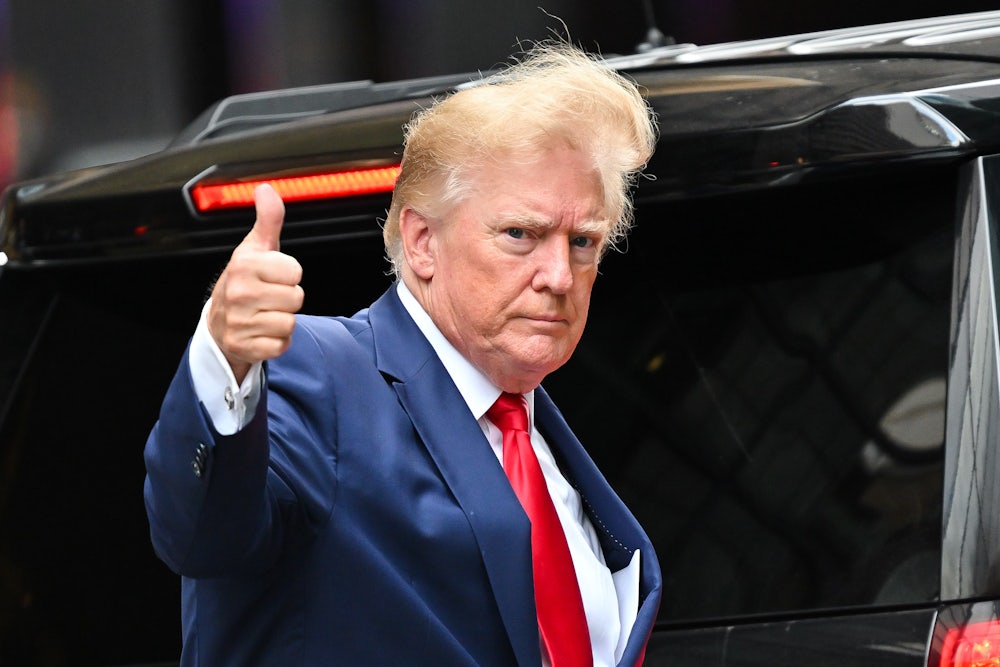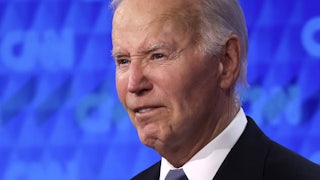In political campaigns, money talks. But are the voters listening?
The cascade of donations to Donald Trump and sympathetic PACs after his conviction on 34 felony counts in May has alarmed Democrats—not only because Trump and the Republican National Committee managed to erase Joe Biden and the Democratic National Committee’s cash-on-hand advantage, but because it suggested Trump’s unique status as a convicted felon running for president was not damaging his campaign. In fact, the $141 million Trump and the RNC raised in May (compared to $85 million for Biden and the DNC) seemed to indicate that Trump’s strategy of casting himself as the victim of some liberal-city conspiracy was working. It was the ultimate middle finger to the establishment, affirming Trump’s appeal to the American aggrieved.
But while candidates need money to run campaigns, it doesn’t necessarily win them elections. It matters where the money comes from, and how it is spent—especially in a year when both presidential candidates are essentially incumbents and well known to the public, and there are few genuinely undecided voters.
So how much should we read into Trump’s recent cash infusion? Not too much—it is less than meets the eye.
First, while disappointing, given what spurred it (a criminal conviction), it should not surprise. There’s a “rally-around-the candidate” burst of donations after Trump has suffered legal blows, Jacob Rubashkin, deputy editor of the nonpartisan Inside Elections, told me. But that’s more a sign of loyalty to Trump and distrust of the system on the part of Americans who were already voting for Trump anyway.
The same could be said for Biden: After his abysmal performance in the June 27 presidential debate, his campaign announced that it had its best single hour of “grassroots fundraising” since the campaign launch, during the 11 p.m. to midnight hour, after the debate was over. (The campaign did not say how much it had raised or how it defined “grassroots fundraising.”) That suggests supporters were not deterred by an incumbent showing that was so weak that Democrats openly discussed replacing their presumptive nominee.
Notably, Trump’s encouraging campaign finance news came right as Biden began to creep up in the polls. With margins of error too often disregarded in the breathless reporting of political polls, the race is essentially tied, regardless of which candidate has a microscopic lead, and is expected to be excruciatingly close this fall. But the trend recently has been in Biden’s favor, polling-wise—hardly a guarantee the president is mounting a major comeback but surely a sign that Trump’s big money haul doesn’t correlate with a surge in voter support.
Nor will money be a deciding factor in this race. Both candidates will have enough cash and can raise more quickly online (gone are the days when candidates had to convince people to write a check, put it in a stamped envelope, and mail it). Both Trump and Biden have problems unique to their own campaigns, but cash isn’t one of them. At some point, collecting millions and then millions more is like standing in the rain for hours: You’re soaked after five minutes, and everything else is just excess.
Television advertising, the highest-profile aspect of campaign spending, is a case in point. “At a certain point, the airways fill up,” especially in battleground states like Arizona, Nevada, Michigan, and Wisconsin, where there are highly competitive Senate races, Rubashkin added. “There’s limited inventory.”
(It’s also not clear those pricey ads make much of a difference: A 2021 study in the American Political Science Review found that TV spots are more likely to move voters in down-ticket races than in presidential contests and that the ads are most effective if they provide “novel information” about the candidates. With Biden and Trump so widely known and heavily examined, is there anything new for voters to learn?)
“Money can affect how nimble the campaign can be, and can affect viability, especially early on,” Sarah Bryner, research director for Open Secrets, told me. But “ultimately, money is not the same as votes.”
One way that politicos do think that money can very roughly correlate with actual human support is the number and size of donations. The rule of thumb is that contributing at least $5 to a candidate gives voters a sense of buy-in and makes it more likely that they’ll actually turn out to vote. That’s why campaigns prize small donations. In this area (at least based on the latest campaign disclosures, which do not cover Trump’s post-conviction surge), Biden has an edge. Small donations (those under $200) make up 42 percent of his campaign chest, according to Open Secrets. Trump, meanwhile, has increasingly relied on large donors ($200 or more) for his fundraising—they made up 14 percent of his total take in 2016, 51 percent in 2020, and a whopping 69 percent this cycle, the outlet reports.
Illustratively, the Trump-supporting PAC Make America Great Again Inc. got a $50 million donation from businessman Timothy Mellon on the day after the former president’s 34 convictions—welcome cash, but not a grassroots flex.
How campaigns spend their lucre matters too. Trump ran a successful, lesser-funded campaign in 2016 by holding big rallies and energizing a part of the electorate that had felt left behind by traditional politicians. In 2024, Trump’s team has lagged in building the state-by-state infrastructure needed to mobilize voters, Jason Cabel Roe, the former executive director of the Michigan Republican Party and now a political strategist, told me. Roe did say he has recently been told that plans are in the works to get boots on the ground—an effort in which that $50 million Mellon money will come in handy. (Team Trump has reportedly outsourced its ground game to outside conservative groups, such as the conservative student group Turning Point USA.) The Biden campaign, meanwhile, notes that it and the DNC have more than 1,000 staffers across the country, and more than 200 offices.
Broadly speaking, money’s role in winning campaigns is often overstated anyway: Contra conventional wisdom, the bigger spender does not always win. Trump himself, notably, won the 2016 presidential election despite being drastically outraised and outspent by Democrat Hillary Clinton. Down the ballot, Angela Alsobrooks, a Senate candidate in Maryland, trounced Representative David Trone in Maryland’s May primary, even though he outspent her by orders of magnitude, laying out $60 million (most of which came from the candidate’s personal fortune) while she only raised (a still impressive) $8 million.
The bottom line: Both campaigns will have a lot of cash to spend. Ultimately, though, “people have to want what you’re selling,” Rubashkin said. And that, neither Trump nor Biden can buy.








